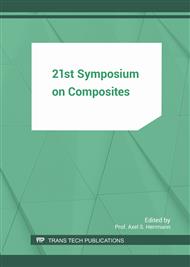[1]
J. Mazumder, J. Koch, J. Nagarthnam, and J. Choi, Rapid manufacturing by laser aided direct deposition of metals, Adv Powder Metall Part Mater, vol. 4, no. 15, p.107–118, (1996).
Google Scholar
[2]
C. Atwood, M. Griffith, M. Schlienger, L. Harwell, M. Ensz, D. Keicher, J. Romero, and J. Smugeresky, Laser engineered net shaping (LENS): A tool for direct fabrication of metal parts, " in Proceedings of the 17th International Congress on Applications of Lasers and Electro-Optics, ICALEO, 98, (1998).
DOI: 10.2351/1.5059147
Google Scholar
[3]
B. Baufeld, O. V. der Biest, and R. Gault, Additive manufacturing of Ti6Al4V components by shaped metal deposition: Microstructure and mechanical properties, Materials and Design, vol. 31, no. Supplement 1, pp. S106 – S111, (2010).
DOI: 10.1016/j.matdes.2009.11.032
Google Scholar
[4]
S. W. Williams, F. Martina, A. C. Addison, J. Ding, G. Pardal and P. Colegrove, Wire + Arc Additive Manufacturing, Materials Science and Technology 2016, DOI 10. 1179/1743284715Y. 0000000073.
DOI: 10.1179/1743284715y.0000000073
Google Scholar
[5]
Taminger, K.M.B. and Hafley, R.A., Characterization of 2219 Aluminium Produced by Electron Beam Freeform Fabrication, Proceedings of 13th SFF Symposium, 482-489, (2002).
Google Scholar
[6]
Brice, C.A., et al., Rapid Prototyping and Freeform Fabrication via Electron Beam Welding Deposition, Proceeding of Welding Conference, (2002).
Google Scholar
[7]
W. P., B. M., and J. M., Electron beam freeforming of stainless steel using solid wire feed, Materials and Design, vol. 28, no. 8, p.2278 – 2286, (2007).
DOI: 10.1016/j.matdes.2006.08.008
Google Scholar
[8]
www. merholdings. com.
Google Scholar
[9]
www. norsktitanium. no.
Google Scholar
[10]
X. Xiong, H. Zhang, and G. Wang, Metal direct prototyping by using hybrid plasma deposition and milling, J Mater Process Technol, vol. 209, no. 1, p.124 – 130, (2009).
DOI: 10.1016/j.jmatprotec.2008.01.059
Google Scholar
[11]
H. Zhang, J. Xu, and G. Wang, Fundamental study on plasma deposition manufacturing, Surf Coat Technol, vol. 171, no. 1-3, p.112 – 118, (2002).
Google Scholar
[12]
M. Katou, J. Oh, Y. Miyamoto, K. Matsuura, and M. Kudoh, Freeform fabrication of titanium metal and intermetallic alloys by three-dimensional micro welding, Journal of Materials and Design, vol. 28, no. 7, p.2093 – 2098, (2007).
DOI: 10.1016/j.matdes.2006.05.024
Google Scholar
[13]
D. Clark, M. Bache, and M. Whittaker, Shaped metal deposition of a nickel alloy for aero engine applications, J Mater Process Technol, vol. 203, no. 1-3, p.439 – 448, (2008).
DOI: 10.1016/j.jmatprotec.2007.10.051
Google Scholar
[14]
Y. -A. Song, S. Park, D. Choi, and H. Jee, 3D welding and milling: Part I direct approach for freeform fabrication of metallic prototypes, Int J Mach Tool Manu, vol. 45, no. 9, p.1057–1062, (2005).
DOI: 10.1016/j.ijmachtools.2004.11.021
Google Scholar
[15]
W. P., B. M., and J. M., Electron beam freeforming of stainless steel using solid wire feed, Materials and Design, vol. 28, no. 8, p.2278 – 2286, (2007).
DOI: 10.1016/j.matdes.2006.08.008
Google Scholar
[16]
G. J. Gibbons and R. G. Hansell, Direct tool steel injection mould inserts through the arcam EBM free-form fabrication process, Assembly Autom, vol. 25, no. 4, p.300–305, (2005).
DOI: 10.1108/01445150510626433
Google Scholar
[17]
Abdul Jimoh, Iakovos Sigalas, Mathias Hermann: In Situ Synthesis of Titanium Matrix Composite (Ti-TiB-TiC) through Sintering of TiH2-B4C, Materials Sciences and Applications, 2012, 3, 30-35.
DOI: 10.4236/msa.2012.31005
Google Scholar
[18]
Z. F. Yang, W. J. Lu, D. Xu, J. N. Qin and D. Zhang, In Situ Synthesis of Hybrid and Multiple-Dimensioned Tita-nium Matrix Composites, Journal of Alloys and Com-pounds, Vol. 419, No. 1-2, 2006, pp.76-80.
DOI: 10.1016/j.jallcom.2005.09.055
Google Scholar
[19]
L. Cai, Y. Zhang, L. Shi, H. Yang and M. Xi, Research on Development of in Situ Titanium Matrix Composites and in Situ Reaction Thermodynamics of the Reaction System, Journal of University of Science and Technol-ogy Beijing, Vol. 13, No. 6, 2006. p.551.
DOI: 10.1016/s1005-8850(06)60112-6
Google Scholar
[20]
T. Saito, The Automotive Application of Discontinuously Reinforced TiB-Ti Composite, Journal of the Mi- nerals, Metals and Materials Society, Vol. 56. No. 5, 2004, pp.33-36.
DOI: 10.1007/s11837-004-0125-3
Google Scholar
[21]
W. Hanusiak, J. Fields, V. Hammond, R. Grabow, C. F. Yolton, The prospects for hybrid fiber-reinforced Ti-TiB-matrix composites, JOM, Vol. 56(5), 2004, 49-50.
DOI: 10.1007/s11837-004-0128-0
Google Scholar
[22]
Stanley Abkowitz, Susan M. Abkowitz, Harvey Fisher, Patricia J. Schwartz, CermeTi® discontinuously reinforced Ti-matrix composites: Manufacturing, properties, and applications, JOM, Vol. 56 (5), 2004, 37-41.
DOI: 10.1007/s11837-004-0126-2
Google Scholar
[23]
M. P. Dariel, N. Frage and L. Levin, A Novel Approach for the Preparation of B4C-Based Cermets, International Journal of Refractory Metals & Hard Materials, Vol. 18, No. 2-3, 2002, pp.131-135.
DOI: 10.1016/s0263-4368(00)00012-3
Google Scholar
[24]
V. V. B. Prasad, J. Subramanyam and B. V. R. Bhat, Preparation of Ti-TiB-TiC & Ti-TiB Composites by in-Situ Reaction Hot Pressing, Journal of Materials Science and Engineering A, Vol. 325, No. 1-2, 2002, pp.126-130.
DOI: 10.1016/s0921-5093(01)01412-5
Google Scholar
[25]
D. R. Ni, L. Geng, J. Zhang and Z. Z. Zheng, Effect of B4C on Microstructure of in Situ Titanium Matrix Composites Prepared by Reactive Processing of Ti-B4C Sys-tem, Scripta Materialia, Vol. 55, No. 5, 2006, pp.429-432.
DOI: 10.1016/j.scriptamat.2006.05.024
Google Scholar
[26]
R. Boyer, G. Welsch, E.W. Collings, Material Properties Handbook: Titanium Alloys1994.
Google Scholar
[27]
https: /www. ife. no/en/ife/departments/materials_and_corrosion_tech/files/facts-and-figures-for-commonly-used-titanium-alloys.
Google Scholar


